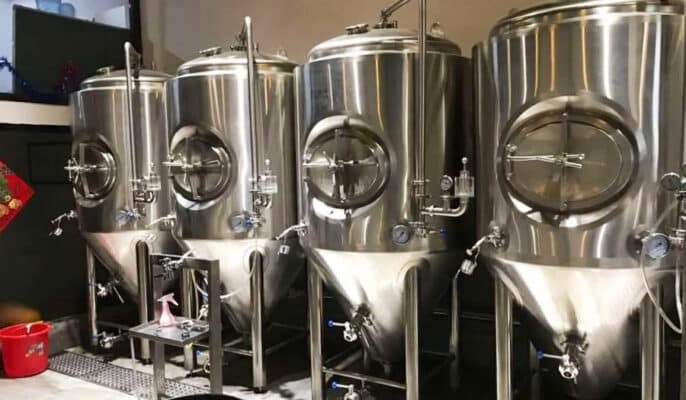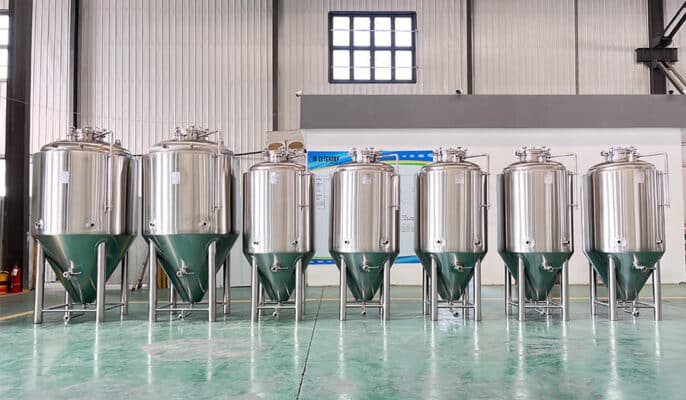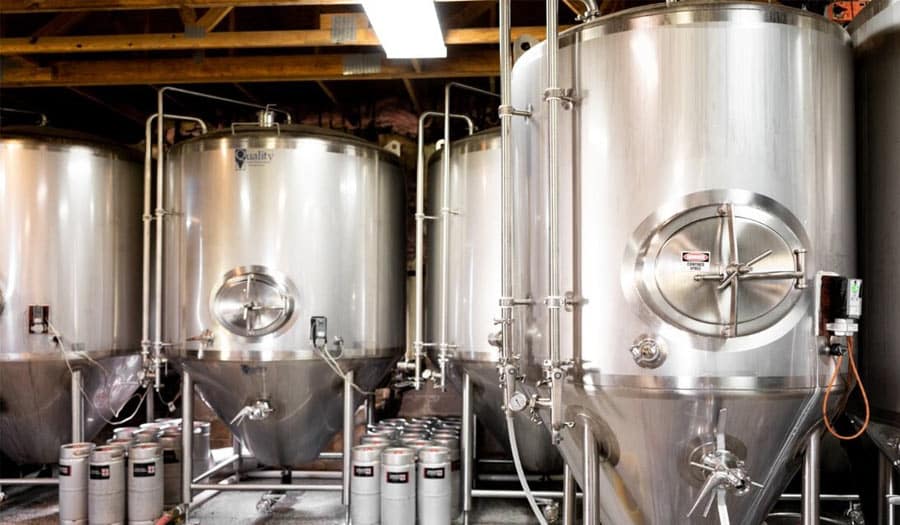Os fermentadores são vitais em várias indústrias, desde a biotecnologia à produção de alimentos e bebidas. Compreender as suas funções básicas é essencial para compreender a sua importância nestas aplicações. Os fermentadores são equipamentos indispensáveis na biotecnologia moderna e nas indústrias alimentares. A sua principal função é proporcionar um ambiente de crescimento adequado para que os microrganismos realizem vários processos de fermentação. Este artigo irá explorar em pormenor as principais utilizações dos fermentadores na vinificação, incluindo os seus princípios de funcionamento, caraterísticas de conceção e aplicações na produção de diferentes tipos de vinho.
Conceitos básicos de fermentação
Antes de nos debruçarmos sobre as utilizações do recipientes de fermentaçãoPara tal, é necessário clarificar os conceitos básicos da fermentação. A fermentação é um processo bioquímico, geralmente catalisado por leveduras, bactérias ou outros microorganismos. Neste processo, a levedura converte o açúcar em álcool e dióxido de carbono, ao mesmo tempo que produz vários compostos de sabor e aroma. No processo de vinificação, a fermentação não é apenas o processo de produção de álcool, mas também um elo fundamental para dar ao vinho o seu sabor e aroma únicos.
A fermentação divide-se em várias fases, incluindo:
- Fermentação primária: Nesta fase, as leveduras começam a proliferar rapidamente, consumindo os açúcares disponíveis e produzindo álcool e dióxido de carbono.
- Fermentação estável: À medida que o açúcar diminui, a atividade da levedura começa a abrandar e a taxa de fermentação diminui.
- Fermentação secundária: Normalmente efectuada após a fermentação primária, o vinho é transferido para remover sedimentos, melhorando assim a sua clareza e sabor.

Como funciona um fermentador
A função básica de um fermentador é promover o processo de fermentação do açúcar pela levedura através do controlo de uma série de factores ambientais. Durante este processo, a levedura converte o açúcar em álcool, dióxido de carbono e uma variedade de compostos aromáticos, que acabam por formar o sabor e as caraterísticas do vinho.
Conversão do açúcar em álcool
Uma das principais funções de um fermentador no processo de vinificação é incentivar as leveduras a converter o açúcar das matérias-primas em álcool. Este processo divide-se em várias etapas:
- Preparação da matéria-prima: As matérias-primas utilizadas na vinificação, como as uvas, o malte ou outras fontes de açúcar, são lavadas, esmagadas e extraídas para obter uma solução açucarada (como o sumo de uva ou a água de maltose).
- Inoculação da levedura: A levedura é adicionada à solução de açúcar preparada. O tipo e a quantidade de levedura afectam diretamente a velocidade de fermentação e a qualidade do produto.
- Processo de fermentação: A levedura começa a multiplicar-se a uma temperatura e a um valor de pH adequados, metabolizando o açúcar e convertendo-o em álcool e dióxido de carbono. Este processo dura normalmente de alguns dias a algumas semanas, dependendo do tipo de vinho produzido e do tipo de levedura.
Controlo ambiental
Os fermentadores estão normalmente equipados com sistemas de controlo avançados para manter e monitorizar as condições ambientais necessárias durante o processo de fermentação. Estas condições incluem:
- Controlo da temperatura: Diferentes vinhos e variedades de leveduras têm diferentes requisitos de temperatura. A maioria dos processos de vinificação é efectuada entre 15-25°C para promover a atividade das leveduras e reduzir a produção de sabores desagradáveis.
- Monitorização do pH: O pH afecta o crescimento da levedura e os resultados da fermentação, e é normalmente mantido entre 3,0-4,0 para obter melhores resultados.
- Gestão do oxigénio: Nas fases iniciais da fermentação, a levedura necessita de oxigénio para se reproduzir; nas fases posteriores da fermentação, o oxigénio tem de ser restringido para evitar a oxidação do álcool e a produção de sabores estranhos.
Agitação e mistura
O sistema de agitação no interior do tanque de fermentação foi concebido para promover a uniformidade do meio de cultura e a dissolução do oxigénio. Através de uma agitação eficaz:
- Aumentar o teor de oxigénio dissolvido: Nas fases iniciais da fermentação, a agitação ajuda a dissolver eficazmente o oxigénio no líquido e a promover a reprodução das leveduras.
- Assegurar a uniformidade: A agitação pode misturar uniformemente a solução de açúcar com a levedura, garantindo que a levedura possa entrar em contacto total com o açúcar, melhorando assim a eficiência da fermentação.

Caraterísticas de conceção do tanque de fermentação
- Seleção do material: As cubas de fermentação são normalmente feitas de materiais como o aço inoxidável, vidro ou plástico para garantir a sua resistência à corrosão e facilidade de limpeza. Os tanques de fermentação de aço inoxidável são amplamente utilizados devido à sua durabilidade e higiene.
- Sistema de vedação: Uma boa conceção de vedação pode evitar a contaminação externa e permitir a libertação de dióxido de carbono. Os tanques de fermentação modernos estão normalmente equipados com válvulas de gás para libertar gás durante a fermentação sem permitir a entrada de ar exterior.
- Sistema de controlo da temperatura: Os tanques de fermentação estão normalmente equipados com dispositivos de controlo da temperatura, incluindo sistemas de aquecimento e arrefecimento, para garantir que a temperatura de fermentação se mantém dentro do intervalo ideal.
- Instrumentos de monitorização: São instalados vários sensores e equipamentos de monitorização no tanque de fermentação, que podem monitorizar parâmetros-chave como a temperatura, o valor do pH e o teor de oxigénio dissolvido em tempo real para garantir a estabilidade e a segurança do processo de vinificação.
- Facilidade de limpeza: Para evitar a contaminação e manter a higiene, a conceção do tanque de fermentação deve ser fácil de limpar e desinfetar. Muitos tanques de fermentação estão equipados com sistemas CIP (cleaning in place) para uma limpeza eficiente.
Aplicação de cubas de fermentação em diferentes tipos de álcool
Produção de cerveja
Utilizando uma cuba de fermentação primária dedicada, a levedura converte o açúcar do malte em álcool e dióxido de carbono nesta fase, que normalmente dura 1-2 semanas. Após a conclusão da fermentação primária, a cerveja é transferida para o tanque de fermentação secundária (ou tanque de maturação) para desenvolver ainda mais o sabor e o aroma nesta fase, que pode durar até vários meses. Os diferentes tipos de cerveja (como a lager e a ale) têm requisitos de temperatura diferentes e os fabricantes de cerveja têm de os ajustar de acordo com o tipo de cerveja.
Produção de vinho
A fermentação com temperatura controlada é frequentemente utilizada e a temperatura é mantida a 12-18°C para proteger as substâncias aromáticas. Os tanques de fermentação para o vinho tinto são geralmente maiores, permitindo que o vinho entre em contacto com as peles das uvas para extrair a cor e os taninos, e a temperatura de fermentação situa-se geralmente entre 20-30°C. Alguns vinhos de alta qualidade são fermentados em barris de carvalho para melhorar ainda mais o seu sabor e complexidade.
Produção de saquê
O processo de fabricação de saquê inclui sacarificação e fermentação simultâneas, e tanques especiais de fermentação são usados para garantir o bom andamento deste processo. A fermentação do saquê tem requisitos elevados de temperatura e humidade e geralmente precisa de ser realizada num ambiente de baixa temperatura e alta humidade para melhorar o efeito de fermentação.

Qual é o principal objetivo de uma cuba de fermentação?
Proporcionar um ambiente de fermentação adequado
A principal função de um tanque de fermentação é proporcionar um ambiente de fermentação adequado para a levedura, incluindo o controlo da temperatura, humidade, teor de oxigénio, etc., para garantir que a levedura trabalhe nas melhores condições. A levedura é muito sensível às condições ambientais. Uma temperatura demasiado alta ou demasiado baixa afecta a sua atividade, o que, por sua vez, afecta a eficiência da fermentação e a qualidade do produto final.
Prevenir a poluição
A conceção do recipiente de fermentação deve assegurar que os contaminantes externos sejam impedidos de entrar. Os recipientes abertos são facilmente contaminados por microrganismos presentes no ar, resultando numa falha de fermentação ou num sabor desagradável. A conceção selada dos recipientes fechados pode reduzir eficazmente o risco de contaminação e proteger a pureza da fermentação.
Controlar a libertação de gases de fermentação.
Durante o processo de fermentação, a levedura produz dióxido de carbono. O tanque de fermentação precisa de ter uma certa quantidade de ventilação para permitir que o dióxido de carbono saia em segurança, mas ao mesmo tempo não pode deixar entrar o ar exterior. Muitos fermentadores modernos estão equipados com válvulas de ar, que são especialmente concebidas para libertar gás mas manter o ar e as impurezas fora.
Promover o desenvolvimento do sabor
O material e o design do recipiente de fermentação afectam o sabor da cerveja ou de outras bebidas fermentadas. Por exemplo, os recipientes de aço inoxidável podem manter o sabor puro da bebida, enquanto os barris de madeira podem dar ao corpo um aroma e um componente de sabor únicos. Ao escolher um recipiente de fermentação, os fabricantes de cerveja têm de considerar o seu potencial impacto no sabor do produto final.
Fácil de limpar e manter
O recipiente de fermentação tem de ser fácil de limpar e higienizar para evitar o crescimento de bactérias e impurezas. Qualquer resíduo ou sujidade pode afetar o processo de fermentação e a qualidade do produto final. Por isso, é crucial escolher um recipiente bem concebido e fácil de limpar.
Suporte para controlo da temperatura
Alguns fermentadores vêm com sistemas de controlo de temperatura incorporados para manter uma temperatura de fermentação constante. O controlo adequado da temperatura é essencial para a atividade da levedura e para os resultados da fermentação. Especialmente quando se produz um estilo específico de cerveja, pequenas mudanças de temperatura podem levar a diferenças significativas no sabor.
FAQ
O que é um fermentador?
Um fermentador é um recipiente especialmente concebido para controlar e otimizar o processo de fermentação microbiana e é normalmente utilizado na produção de vinho, produtos lácteos, produtos farmacêuticos e biocombustíveis.
Como é que um fermentador afecta a qualidade do produto?
Os parâmetros de conceção e controlo do fermentador (como a temperatura, o pH e o oxigénio) afectam diretamente o crescimento e o metabolismo dos microrganismos, que por sua vez afectam o sabor, o aroma e a qualidade do produto final.
Quais são as principais utilizações de um fermentador?
- Transformar os açúcares em álcool e outros produtos de fermentação.
- Controlar os parâmetros ambientais como a temperatura, o pH e o oxigénio dissolvido durante o processo de fermentação.
- Proporcionar agitação e mistura adequadas para melhorar a eficiência da fermentação.
- Evitar a contaminação e garantir a segurança do produto.




